ROAMING AROUND KANSAS – WHERE THE BUFFALO ROAM
ROAMING AROUND KANSAS
This is the 6th in a series of articles about touring the state of Kansas
WHERE THE BUFFALO ROAM
By Charles N. Stevens
Photos by Dolores Seidman
The day dawns clear, the reddish glow of the rising sun tinting the tall grain silos and city water tower with a rosy blush. Steam from nearby stacks leans toward the east. Our motel window looks out on route I-135 and US 56, both amazingly free of cars, so different from the main arteries in California.
We leave in the morning under a buttermilk sky, our bus heading for US 36 East. The bus leaves the highway near the small town of Canton. We notice that there are no fences between the yards and houses or no sidewalks, one person’s yard blending into the next, a reflection of the way they feel about each other— trusting and friendly.
Soon we are off on a dirt road, riding along beside a tall wire fence that encloses native land containing only a few trees and prairie grasses. It is much as it was hundreds of years ago. We pull up to a barn-like structure, the offices of the Maxwell Wildlife Refuge. We leave the bus and walk out into the chilly air as a guide tells us that the refuge contains over 60 buffalo and 90 elk. From where we are, we can look out over the hilly prairie where we see a heard of buffalo (or bison) grazing on the tawny grass.
After we take our seats in a white metal trailer, a truck begins pulling us out toward the buffalo herd. I assume we are going to a place where we can see them closer, but it becomes apparent that we are going right into the middle of them. Ahead of us is a truck that’s dumping large pellets that they call “buffalo candy”, something the animals find very tasty. This keeps them happy and occupied as our truck and trailer pushes slowly through them. Soon we are surrounded by the buffalo, large bulls that push the others around, calves crying for their mothers and the smaller females trying to get their share. I can see the light in their eyes and hear the sound of their hooves pounding the dirt. They are all moving around and jostling one another as they snort, puff and grunt, perhaps wondering what we are all about. A few roll their bodies in dusty wallows, their legs flailing, clouds of dust drifting from their wallowing. Others calmly munch the prairie grasses. Our guide tells us that males can live for 20 years and attain a weight of 2,000 pounds and that females leave the herd to bear their calves. I had never been so close to these magnificent beasts and probably never will again. What an experience!
In late morning we leave the buffalo and turn east on Highway 56. I’m surprised to see an oil well pumping in the middle of a cornfield. As we travel eastward the terrain becomes hillier with more range land for herds of black cattle.
We finally arrive at the small town of Cottonwood Falls, a town so old that the streets are still paved with red bricks. We gather in the Grand Central Hotel, built in 1881, for lunch, a very nice feast of southwest salad with chicken strips followed by peach pie topped with ice cream. Luscious! As we walk through the small town we come upon a unique shop called the Fiber Store where the owners weave almost anything out of strips cut from used blue jeans. But our main objective here is to walk to the town’s magnificent Chase County Courthouse built in 1871 and still in use. A perky city guide leads us up a beautiful staircase fashioned out of polished black walnut and into the courtroom which looked quite modern inside. From this lofty height we look through a round window at the main street of the town and get an idea of how small the town is. Lastly, we visit the old courthouse jail, no longer used, the old iron cells hard and cold.
On Highway 177 north we find the Tall Grass Prairie Nature Preserve. A ranger boards our bus as we retrace our path to a demonstration area of tall grasses. The ranger tells us that there was once 170 million acres of tall grasses, only 4% of which exists today. We stop at the Flint Hills Lookout where we can gaze out over the prairie as the ranger talks. It is sunny and warm here with grasshoppers leaping in the grasses and dragon flies cruising above. The guide explains that 20% of Kansas has a base of limestone and flint.
By late afternoon we are at the Pioneer Bluffs Farm Site where we gather in a barn for snacks. We wander around the pleasant grounds, enjoying the rural atmosphere and the great oak trees. We return to the barn for a home cooked dinner of beef, green beans, scalloped potatoes, biscuits and apple pie. This would have been nice except that the flies wanted to eat there too. After dinner we take our places around a smoky campfire to hear Jeff Davidson sing with his guitar. Through song and comment he tells the story of the cowboy and the movement of cattle from Texas to Abilene. As he sings I notice the brilliant slant of sunlight on the cornfield and the flickering shadow of the turning windmill on the side of the barn.
We are treated to a brilliant sunset as our bus carries us toward Emporia, Kansas and our motel for tonight.
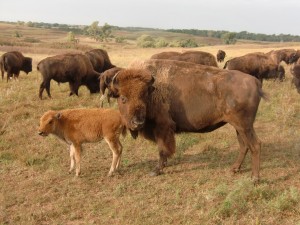
Out among the buffalo a young calf whimpers for its mother.
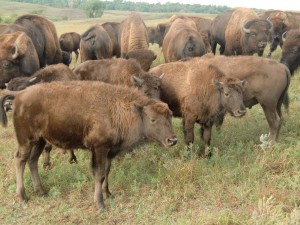
The buffalo eye us as we pass through them on our special trailer.
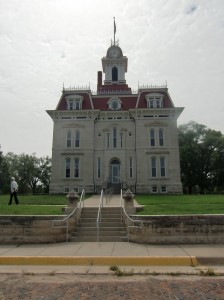
Cottonwood Falls boasts of the historic Chase County Courthouse built in l871 and still being used today.
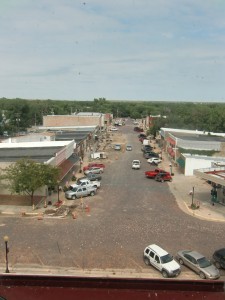
Through this window in the courthouse we can see how small the town of Cottonwood Falls is.
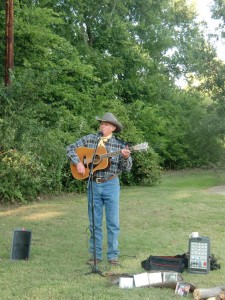
At the Pioneer Bluffs Farm Jeff Davidson sings cowboy songs about the driving of cattle from Texas to Abilene, Kansas.
MONTEREY PARK AUTHOR PUBLISHES 4th BOOK – Seeking More of the Sky: Growing Up in the 1930’s:
Charles “Norm” Stevens, a 43 year resident of Monterey Park has recently published his 4th book: Seeking More of the Sky: Growing Up in the 1930’s. This is the story of a young boy growing up in Inglewood, California in the l930’s. This was a time during the depression when unemployment was affecting many and the banks were closed, while the clouds of war were gathering in Europe. But he was lucky enough to be raised in a loving family, the power of that love reflected throughout his stories.
Stevens is the author of three previous books about his experiences during WWII:
An Innocent at Polebrook: A Memoir of an 8th Air Force Bombardier (Story of his 34 bombing missions from his base at Polebrook, England over Germany and France)
The Innocent Cadet: Becoming A World War II Bombardier (A prequel to the first, telling of his training in the U.S. before going overseas into combat.)
Back from Combat: A WWII Bombardier Faces His Military Future from Combat: (This book details the time from when he returned from combat in England until the end of the war.)
He is known to the readers of The Citizen’s Voice as the author of Travel Log Articles including “Cruising the Rhine and Mosel”,” Best of the West”, “In Search of Snow” , “From Paris to Normandy on the Seine”, and “Exploring New York”. He is retired, having taught for 32 years, primarily in the Montebello Unified School District.
Those interested in purchasing an autographed copy of any of his books, may contact the author at 323-721-8230 or Normstevens24@gmail.com.



